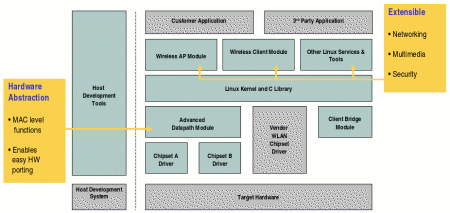Linux Wi-Fi stack aims to vastly widen wireless device deployments
Feb 28, 2005 — by Henry Kingman — from the LinuxDevices Archive — viewsWLAN software specialist Instant802 has renamed itself as Devicescape, and launched an off-the-shelf Linux Wi-Fi stack meant to speed the arrival of ubiquitous wireless networking. Universal Wireless Platform (UWP) 2.0 includes a Linux reference design and Eclipse-based tools, and targets consumer electronics devices, office equipment, and network infrastructure.
Previously, Instant802 offered development services to companies building wireless devices. Now, as Devicescape, it will sell packaged Wi-Fi stacks and development kits that enable device builders to roll their own standards-compliant, interoperable Wi-Fi implementations, with advanced features such as central manageability, WPA2 over WDS links, and multiple virtual wireless networks.
CEO Dave Fraser, who joined the company last October after 13 years with Wind River, says new name reflects a widening mission to foster the proliferation of wireless-enabled mobile and fixed devices, which together will comprise a “devicescape.” Said Fraser, “The name 'Devicescape' is a reminder of our mission to usher in the second generation of the Internet, with billions of devices that are interacting with human beings, interacting with each other, and linked by wireless connections whether they are mobile products or not.”
 According to Fraser, UWP represents the first commercial packaging of technology already widely used in products such as Gateway's SMB access points, Sharp's Galileo PVR/Wi-Fi access point (pictured), Epson's Powerlite WLAN projector, and others. “One good example is the D-Link DWL2210 AP, a business class access point for small- to medium-sized businesses. If you unwrapped a bunch of these boxes in a small business, you could power them on and they would all seek out each other and configure themselves as a cluster with a single point of management. They'd also secure themselves, and start up an authentication service within the cluster. It's a low-cost product, [and] the devicescape software [gives] it a very low cost of deployment. That's the device-to-device intelligence that we specialize in.”
According to Fraser, UWP represents the first commercial packaging of technology already widely used in products such as Gateway's SMB access points, Sharp's Galileo PVR/Wi-Fi access point (pictured), Epson's Powerlite WLAN projector, and others. “One good example is the D-Link DWL2210 AP, a business class access point for small- to medium-sized businesses. If you unwrapped a bunch of these boxes in a small business, you could power them on and they would all seek out each other and configure themselves as a cluster with a single point of management. They'd also secure themselves, and start up an authentication service within the cluster. It's a low-cost product, [and] the devicescape software [gives] it a very low cost of deployment. That's the device-to-device intelligence that we specialize in.”
“We have executed about 20 different design wins so far,” adds Fraser, “and Linux has been the OS in most of those design wins.”
UWP 2.0
The UWP includes a WLAN software framework, including a dynamically loadable kernel module and user-space applications. It also includes a reference embedded Linux operating system based on a 2.4.27 kernel, wireless tools, and an Eclipse-based cross-development framework. The Platform supports ARM/XScale, MIPS, and IA-32, along with WLAN chipsets from Atheros, Broadcom, and Conexant.

Universal Wireless Platform 2.0 architecture
(Click to enlarge)
According to Fraser, the Linux environment included with UWP is “standard” Linux, packaged to include features customers would need, and “definitely suitable to go into production with.” However, states Fraser, “We're not trying monetize [our Linux implementation]. All power to the guys that are trying to make money from Linux. Good luck to them. We're trying to add value by incorporating Linux, but all of our development energy is going toward making linux a better wireless platform, essentially.”
Additionally, Fraser says, the company put a great deal of effort into Device Studio, which he describes as “a very nice, professional Eclipse-based development environment.”
Fraser adds that customers can deploy UWP's WLAN framework on top of their own Linux implementations, or work with UWP using their existing development tools.
Market prospects
According to Fraser, Devicescape is well-positioned to capitalize on growing demand for advanced, standards-compliant Wi-Fi stacks. “We're the only software that is used in the 'golden test' unit of the Wi-Fi Alliance. so when there's a box with the Wi-Fi Alliance sticker on it, that's our software that all of the manufacturer's gear gets tested against.”
Further, Fraser notes that Wi-Fi has emerged as one of the most successful networking technologies in history. “It's one of the three networking technologies that have ever gone beyond 200 million units per year, along with analog modems and Ethernet. There's just a mountain of design activity around consumer electronics gear with wireless.”
Wai Sing Lee, industry analyst, Information Technology Research, Frost & Sullivan, said, “With wireless devices becoming widely available, manufacturers and users alike are seeking simplicity in configuring, connecting, securing and managing them. A comprehensive software platform that provides interoperability with the latest wireless LAN technologies, and thus enabling the rapid creation of a variety of devices with rich functionality, will increase adoption.”
This article was originally published on LinuxDevices.com and has been donated to the open source community by QuinStreet Inc. Please visit LinuxToday.com for up-to-date news and articles about Linux and open source.